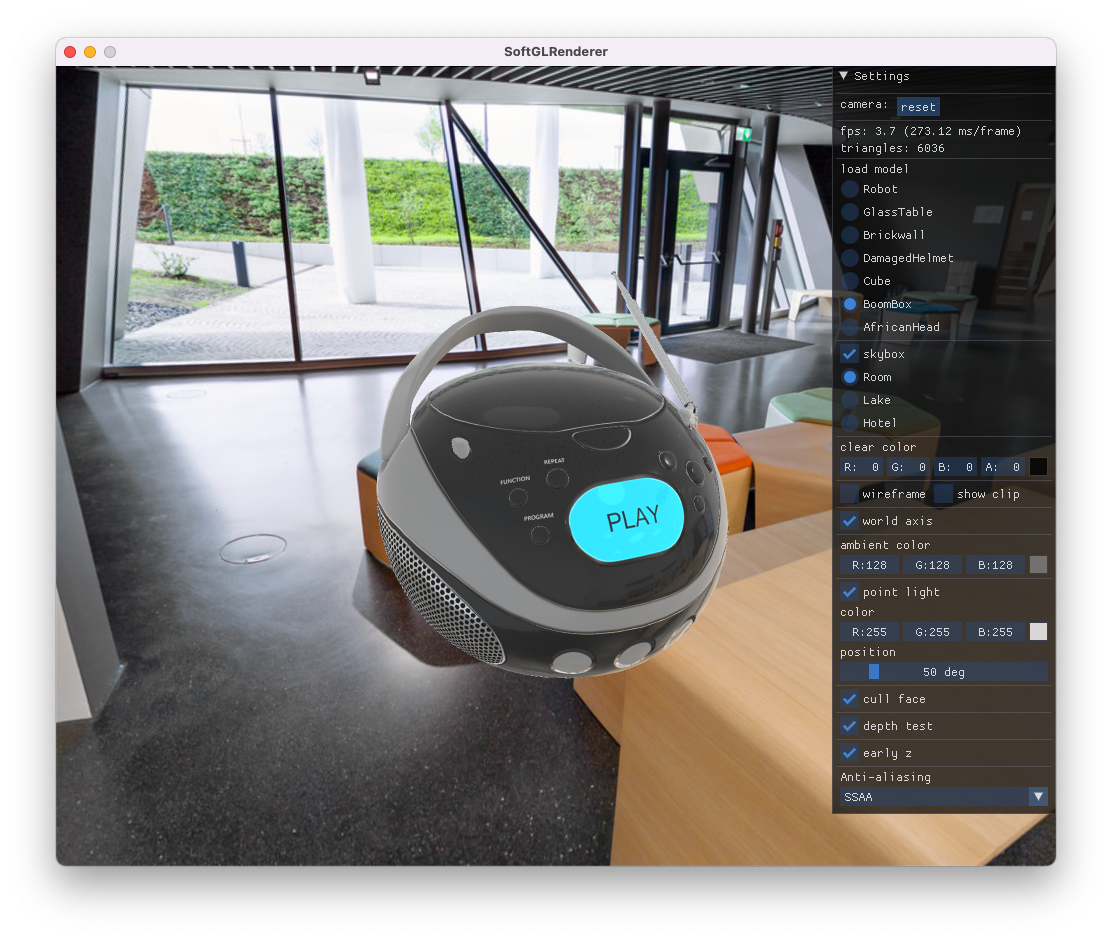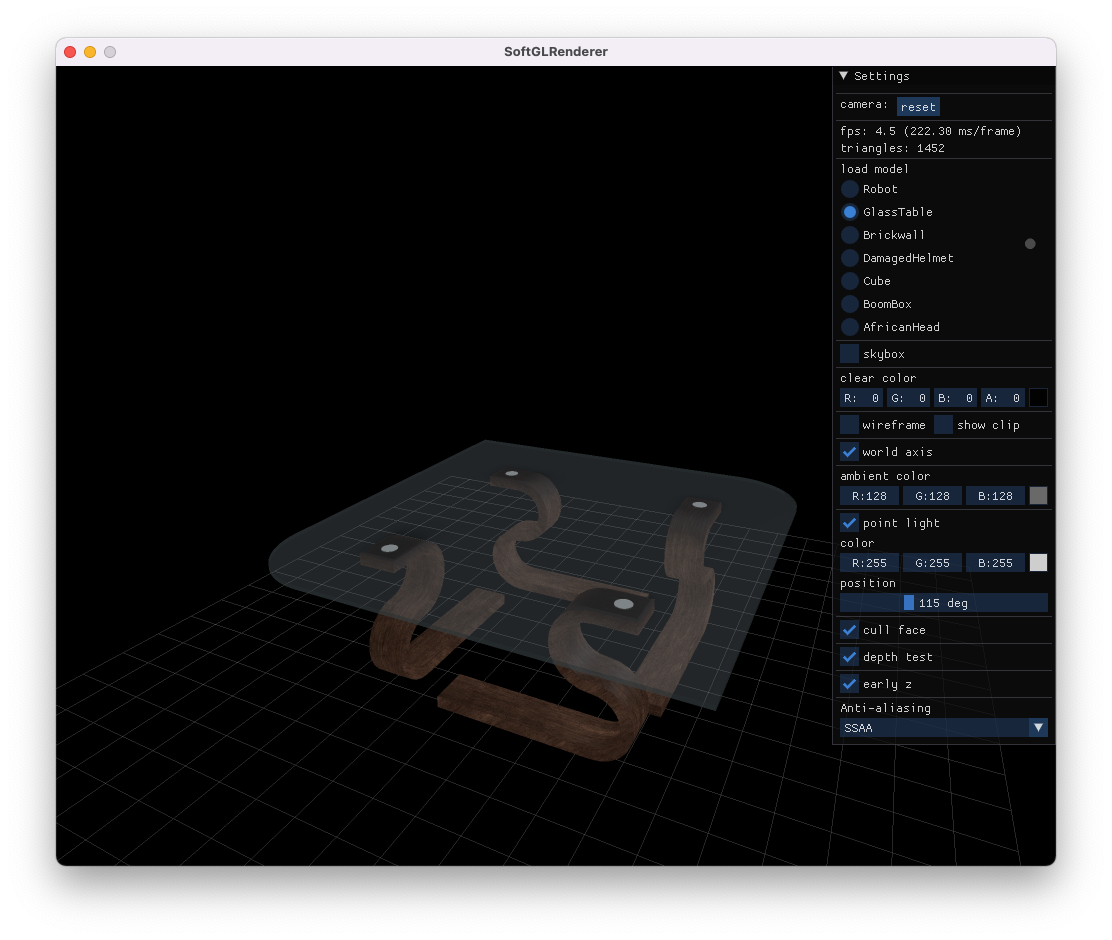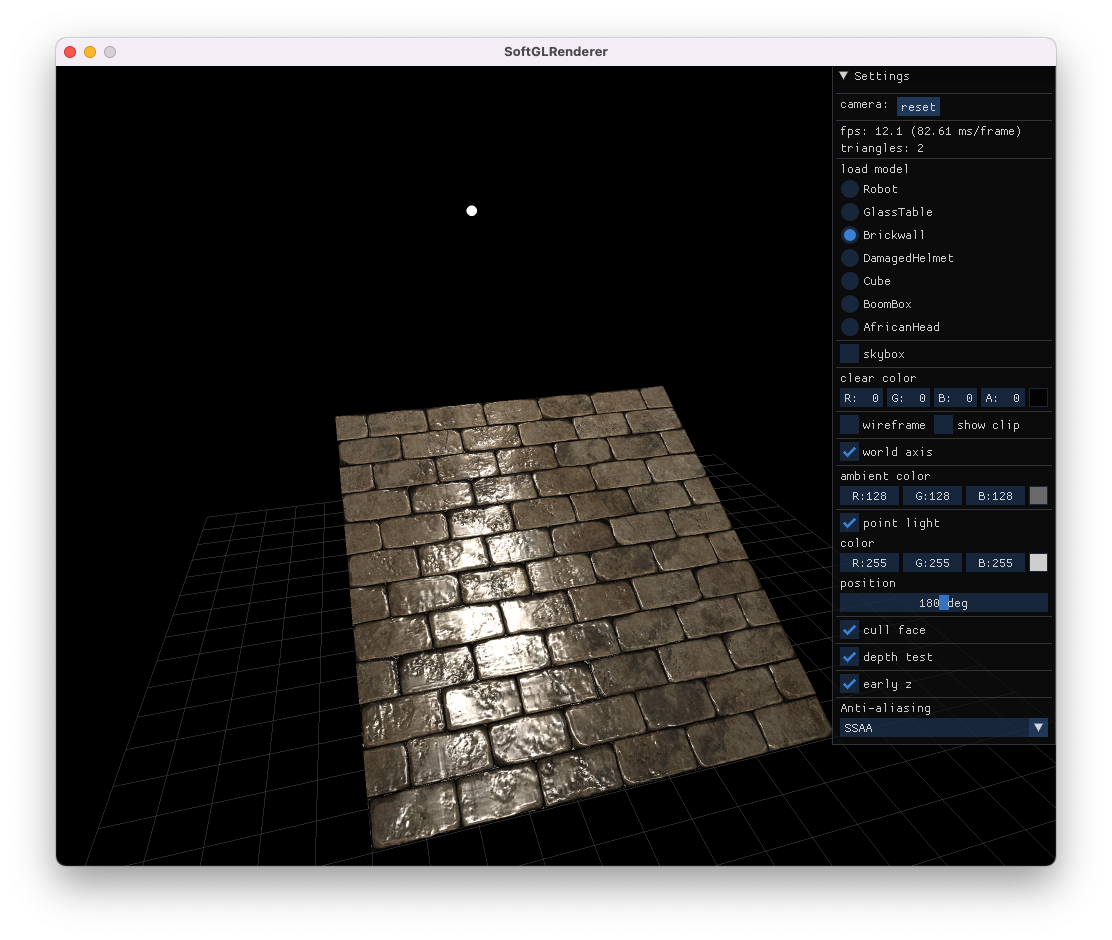Tiny C++ software renderer/rasterizer that implements the main steps of the GPU rendering pipeline, including point, line and polygon rasterization, texture mapping, depth testing, color blending, etc., and emulates vertex shaders and fragment shaders using C++, 3D models (GLTF) are loaded by Assimp, and using GLM as math library. The project also adds OpenGL and Vulkan renderers implementation, you can switch between them (Software/OpenGL/Vulkan) in real time while running.
The purpose of this project is to provide a starting point for developers who want to learn about modern graphics programming.
 |
 |
 |
 |
 |
 |
- Vertex shading
- View Frustum culling (line & triangle)
- Perspective Correct Interpolation
- Back-Front face culling
- Point/Line/Triangle rasterization
- Fragment Shading
- Shader derivative
dFdxdFdy - Depth test & Alpha blending
- Early Z test & Reversed Z
- MSAA 4x
- Mipmaps generation and sampling
- Sample parameters:
Lod,Bias,Offset - All kinds of texture filtering & wrapping mode
- Image storage tiling and swizzling
- Linear: pixel values are stored line by line, commonly used as image RGBA buffer
- Tiled: block base storage, inside the block pixels are stored as
Linear - Morton: block base storage, inside the block pixels are stored as morton pattern (similar to zigzag)
- Multi-Threading: rasterization is block based with multi-threading support
- SIMD: barycentric coordinate calculation, shader's varying interpolation, etc.
- Config panel based on
imgui - Orbit camera controller
- Blinn-Phong shading
- PBR & IBL shading
- Skybox cubeMap & equirectangular
- Shadow mapping
- FXAA anti-aliasing
- RenderDoc in-application frame capture
All renderers (Software/OpenGL/Vulkan) are implemented based on this abstract renderer class:
class Renderer {
public:
// framebuffer
std::shared_ptr<FrameBuffer> createFrameBuffer(bool offscreen);
// texture
std::shared_ptr<Texture> createTexture(const TextureDesc &desc);
// vertex
std::shared_ptr<VertexArrayObject> createVertexArrayObject(const VertexArray &vertexArray);
// shader program
std::shared_ptr<ShaderProgram> createShaderProgram();
// pipeline states
std::shared_ptr<PipelineStates> createPipelineStates(const RenderStates &renderStates);
// uniform
std::shared_ptr<UniformBlock> createUniformBlock(const std::string &name, int size);
std::shared_ptr<UniformSampler> createUniformSampler(const std::string &name, const TextureDesc &desc);
// pipeline
void beginRenderPass(std::shared_ptr<FrameBuffer> &frameBuffer, const ClearStates &states);
void setViewPort(int x, int y, int width, int height);
void setVertexArrayObject(std::shared_ptr<VertexArrayObject> &vao);
void setShaderProgram(std::shared_ptr<ShaderProgram> &program);
void setShaderResources(std::shared_ptr<ShaderResources> &uniforms);
void setPipelineStates(std::shared_ptr<PipelineStates> &states);
void draw();
void endRenderPass();
};To build the project, you must first install the following tools:
- CMake 3.10 or higher
- Compiler environment with C++11 support
If you want to run the vulkan renderer, you need to install vulkan library as follows:
- Download the Vulkan SDK from the official website: https://vulkan.lunarg.com/sdk/home
- Install the SDK on your system. The installation process may vary depending on your operating system.
- Set the environment variable VULKAN_SDK/VK_ICD_FILENAMES/VK_LAYER_PATH to the path where you installed the SDK.
To get the code for this library, you can clone the GitHub repository using the following command:
git clone https://github.com/keith2018/SoftGLRender.gitAlternatively, you can download the source code as a ZIP file from the GitHub repository.
To build the project, navigate to the root directory of the repository and run the following commands:
mkdir build
cmake -B ./build -DCMAKE_BUILD_TYPE=Release
cmake --build ./build --config ReleaseThis will generate the executable file and copy assets to directory bin, which you can run by executing the following
command:
cd bin/Release
./SoftGLRenderassets: GLTF models and skybox textures,assets.jsonis the index of all model & skybox materialssrc: Main source code directoryBase: Basic utility classes like file, hash, timer, etc.Render: Renderer abstraction, include vertex, texture, uniform, framebuffer, etc.Software: Software renderer implementationOpenGL: OpenGL renderer implementationVulkan: Vulkan renderer implementation
Viewer: GLTF loading (based on Assimp), camera & controller, config panel, and render pass managementShader/GLSL: GLSL shader code, for OpenGL & Vulkan rendererShader/Software: C++ simulation of vertex shaders and fragment shaders
third_party: External libraries and assets
assimphttps://github.com/assimp/assimpglfwhttps://github.com/glfw/glfwglmhttps://github.com/g-truc/glmglslanghttps://github.com/KhronosGroup/glslangimguihttps://github.com/ocornut/imguijson11https://github.com/dropbox/json11stb_imagehttps://github.com/nothings/stbvmahttps://github.com/GPUOpen-LibrariesAndSDKs/VulkanMemoryAllocator
If you would like to contribute to the project, you are welcome to submit pull requests with bug fixes, new features, or other improvements. Please ensure that your code is well-documented and adheres to the project's coding standards.
This code is licensed under the MIT License (see LICENSE).